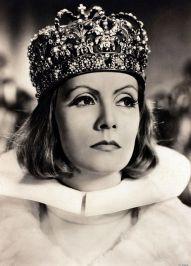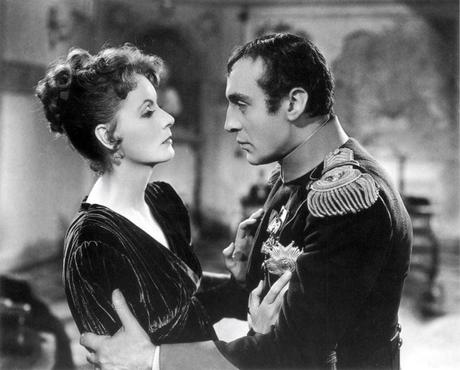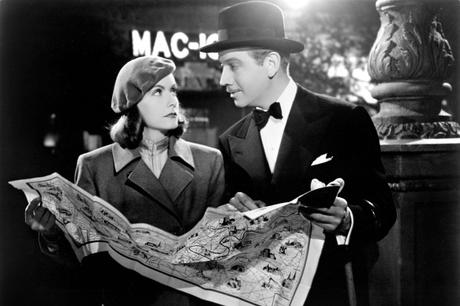
At the peak of Greta Garbo’s career, she occupied a level of stardom that was unmatched by anyone. Not only was she making one acclaimed movie after another, her legendary, the public was captivated by her elusive, enigmatic image. Norma Shearer may have been Queen of the Lot at MGM, but Greta Garbo was in a league of her own. Other studios tried to find their own versions of Garbo, but as often as she was imitated, she was never quite duplicated.
Greta Garbo came to the United States from Sweden in 1925 after Louis B. Mayer saw her performance in The Saga of Gosta Berling and was struck by her on-screen magnetism. After joining MGM, she quickly made a name for herself playing a series of vamp characters in movies like Torrent and The Temptress. Her rise to stardom took off like a shot when she starred opposite John Gilbert in 1926’s Flesh and the Devil, marking the beginning of an on-screen and off-screen relationship between the two stars.
As the 1920s wore on, her star only continued to rise, but by the end of the decade, the advent of talking pictures posed a threat to her white-hot career. Numerous other stars of the silent era saw their careers come to an end around this time because, like Garbo, they had come to America from Europe and had heavy accents. But Garbo was such a big star that MGM would’ve taken a big financial hit if she didn’t successfully make the transition to sound. So MGM took their time in finding the right vehicle for her to make her talkie debut in. Her big moment came in 1930’s Anna Christie and the wait was worth it. Anna Christie was a success and ushered in a new era in Garbo’s career.
In 1932, the time came for Garbo to negotiate a new contract with MGM. She was often frustrated by the roles MGM cast her in and longed for more creative control. And, of course, her megastar status merited a pay raise. MGM gave her both of those things and her new contract not only allowed her to choose her own projects, she also had say in her co-stars and her directors. By this time, she had also developed a very close friendship with actress/screenwriter Salka Viertel, who was extremely influential in shaping Garbo’s career choices.

Many of the projects Viertel steered Garbo towards had a strong European appeal. Prior to her 1932 contract negotiation, most of Garbo’s movies earned more domestically than they did in foreign markets, or at least the two markets were pretty close. For example, Grand Hotel earned $1,235,000 domestically and $1,359,000 in foreign markets and Anna Christie earned $1,013,000 domestically and $486,000 in foreign distribution. On the other hand, Queen Christina earned $767,000 domestically and $1,843,000 foreign and 1935’s Anna Karenina earned $865,000 domestically compared to $1,439,000 foreign.
In 1936, Garbo had a career triumph starring in Camille opposite Robert Taylor. Producer Irving Thalberg took efforts to prevent the movie from feeling like just another stuffy costume picture and Garbo’s remarkably open performance is still regarded as one of her best. Camille went on to become a big hit both in the States and overseas. It was said to be her personal favorite of her own movies and she earned her a Best Actress Academy Award nomination for her work in it. However, Garbo was initially reluctant to make Camille. Thalberg wanted her to do Camille, but she was concerned it would be too similar to Anna Karenina and really wanted to do a movie about Marie Walewska, a mistress of Napoleon’s, instead. She only agreed to do Camille on the condition that she would also get to do the Marie Walewska movie as well. Ironically, this agreement brought her from a career high point to the first real low point of her career: 1937’s Conquest.

Up until 1937, Garbo was anything but Box Office Poison to MGM. 1926’s The Temptress lost $43,000, but that had been the only one and that loss is practically pocket change compared to the $1,397,000 that would be lost on Conquest. To help put that in perspective, when you adjust those amounts for inflation to reflect 2019 dollar values, that’s $604,671 lost on The Temptress compared to $24,939,125 lost on Conquest.
When the Independent Theater Owners Association included Garbo’s name in the Box Office Poison ad in May 1938, Conquest was exactly what they were referring to. It was the only movie she made in 1937 and she did not appear in a movie at all in 1938. Conquest cost $2.7 million to produce and a good portion of that went to paying its stars. Under her contract, Garbo earned $250,000 per movie and MGM had to pay $125,000 to get Charles Boyer for the role of Napoleon. Production also went considerably over schedule and both stars had clauses in their contracts that allowed them to get extra pay when production ran long. Garbo got an extra $100,000 on top of her usual salary and Boyer ended up being paid a total of $450,000.
Charles Boyer earned an Oscar nomination for his performance as Napoleon, but audiences simply couldn’t muster up much enthusiasm for Conquest. Many people found Boyer’s Napoleon more compelling than Garbo’s Marie Walewska, so for the first time, it was a Garbo movie that didn’t really feel like a Garbo movie. Given that the story of Conquest involved adultery and production codes were being enforced in 1937, writers were limited in what could be done with the script. However, what did make it into the final script wasn’t exactly engaging.
Not only was Conquest a major loss for the studio, by the time it was released, World War II was on the horizon and MGM realized they could no longer rely on European markets to pull in the profits Garbo’s movies needed. She needed a movie that would do very well in the United States. After spending much of her time at MGM playing characters like vamps, queens, and spies or starring in lavish costume pictures, it was time for the elusive, untouchable Greta Garbo to be brought down to Earth.

Just as thoughtful planning helped Garbo transition to sound films, it helped Garbo transition into comedy. Ninotchka was released in November 1939 and the delightful comedy helped bring Garbo back to the top of the box office. She had a great director in Ernst Lubitsch, a wonderful screenplay written by a team of writers that included Billy Wilder, and a perfect leading man in Melvyn Douglas. When Oscar season came around, it was nominated for four Academy Awards, including Best Picture and Best Actress. When people talk about 1939 being Hollywood’s golden year, Ninotchka is one of the most widely cited examples supporting that claim.
Unfortunately, Garbo’s comeback would prove to be short lived. With the success of Ninotchka, MGM was eager to get her into another romantic comedy with Melvyn Douglas. Two-Faced Woman was released in 1941 and was a critical disaster. The plot, in which Garbo’s character pretends to be her fictional twin sister in an attempt to save her marriage, is sheer nonsense and many critics and moviegoers were appalled to see Garbo in such a ridiculous movie. It wasn’t Garbo’s finest performance, nor was it Melvyn Douglas’s, although Constance Bennett has some good moments in it. One critic described it as being as shocking as seeing your mother drunk. Others critics liked Garbo’s performance but hated the writing.
The reviews for Two-Faced Woman were the worst of her career. Garbo’s close friend Mercedes de Acosta later wrote that Garbo was humiliated by the reviews, but added, “I think Greta’s greatest regret was more in her own soul for having allowed herself to be influenced into lowering her own high standards.”
Two-Faced Woman also had the disadvantage of being released very shortly before the bombing of Pearl Harbor. With the United States officially heading into World War II, Garbo knew it was time for her to take a break. She understood how important the European market was to her films and volunteered to bow out of films for the duration of the war. Louis B. Mayer agreed, but she never returned to MGM and Two-Faced Woman ended up being the final movie of her career.
Garbo hadn’t intended to fully retire from films after Two-Faced Woman, but any plans for films after that point never materialized. She continued to receive offers and in 1948, she filmed screen tests for what would have been an adaptation of La Duchess de Langelais co-starring James Mason and directed by Max Ophuls. However, funding couldn’t be secured and the project never happened, much to Garbo’s disappointment. Investors were concerned that she would no longer draw crowds at the box office. So while Garbo did briefly beat the Box Office Poison label, she never really escaped it, even after leaving Hollywood.
Advertisements